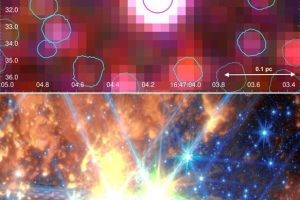Wd1-9, a young Wolf-Rayet star hidden by a dusty cocoon. The study: “EWOCS-IV: 1Ms ACIS Chandra observation of the supergiant B[e] star Wd1-9” of K. Anastasopoulou (INAF – OAPA) recently appeared on A&A

The analysis of a long X-ray observation reveals the nature of the mysterious star Wd1-9: a binary system containing a star that has recently evolved into the Wolf-Rayet phase, after expelling the outer layers of its atmosphere, which were accreted onto the companion star.
Among the at least one hundred billion stars hosted by our Galaxy, there are a few, exceedingly rare ones, that alone can teach us a great deal about stellar evolution and complex physical processes that would otherwise be impossible to study or test. This is certainly the case for massive stars observed in transitional phases of their evolution, among the most valuable objects in stellar physics.
Massive stars are in fact rare compared to stars of low or intermediate mass. Moreover, their lifespans are extremely short — just a few million years — making their intermediate or transient evolutionary stages particularly difficult to observe.
A prime example of such objects are the B[e] supergiants (sgB[e]), an enigmatic class of massive stars characterized by: intense emission in hydrogen and ionized metal lines and strong infrared emission, indicating the presence of dense circumstellar dust clouds.
To date, only twelve such stars are known in the Milky Way, and among them, only two are associated with a stellar cluster — a crucial property for determining their age, essential for evolutionary studies: MWC 137 in Sh2-266 and Wd1-9 in the Westerlund 1 super star cluster.
Astrophysicist Konstantina Anastasopoulou (INAF – Palermo Astronomical Observatory) led a new study focused on Wd1-9, based on a long X-ray observation by the NASA Chandra satellite. These observations have been carried out as part of the EWOCS project (Extended Westerlund 1 and 2 Open Clusters Survey), led by M. G. Guarcello (INAF-OAPA), aimed at studying stellar and planetary formation and the early evolutionary stages in super star clusters.
The study has revealed several secrets of this mysterious star. Analysis of the Chandra observations revealed a periodicity of about 14 days in the intensity of its X-ray emission, which the authors interpret as the result of orbital modulation in a close binary system (two stars in a tight orbit). Supporting this interpretation, X-ray spectroscopy shows the presence of plasma at temperatures exceeding 30 million degrees and highly ionized heavy elements (such as iron) — all typical features of colliding stellar winds in massive binary systems.
The observed orbital period and a simplified theoretical model used to reproduce the observed X-ray emission suggest that Wd1-9 consists of a star that recently evolved into the Wolf-Rayet phase, after losing its hydrogen-rich outer layers, which were accreted by its OB-type companion via Roche lobe overflow — a process typical of Case B mass transfer (the Roche lobes are equipotential surfaces surrounding the stars in a binary system, allowing for mass exchange between the stars).
These results make Wd1-9 a highly significant object for astrophysics, ideal for studying the final evolutionary stages of massive stars and the high-energy physical processes that can only be explored in such systems.
The study is detailed in the article: “EWOCS-IV: 1Ms ACIS Chandra observation of the supergiant B[e] star Wd1-9”, recently published in Astronomy & Astrophysics. Co-authors list includes M. G. Guarcello, S. Sciortino, E. Flaccomio, and F. Damiani from INAF – Palermo Astronomical Observatory.
The cover figure (click [here] to view full size) shows:
- Upper panel: the X-ray image (Chandra/ACIS) of Wd1-9, with nearby faint X-ray sources;
- Lower panel: the mid-infrared image obtained with JWST/MIRI, showing a field about 10 times larger than the Chandra image and highlighting the complex environment surrounding Wd1-9, located at the center, near the red supergiant W26, also extremely bright.
Mario Giuseppe Guarcello
Follow MarioSpiegaCose on Instagram () , Facebook (), Youtube (), and X ()
Follow the Astronomical Observatory of Palermo on Facebok and on Instagram
Subscribe the Youtube channel of the Astronomical Observatory of Palermo
